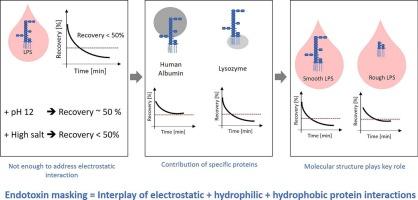Endotoxin masking in human plasma: The role of protein interactions and lipopolysaccharide structure
IF 4.3
2区 医学
Q1 PHARMACOLOGY & PHARMACY
European Journal of Pharmaceutics and Biopharmaceutics
Pub Date : 2025-06-13
DOI:10.1016/j.ejpb.2025.114786
引用次数: 0
Abstract
Reliable endotoxin detection in human plasma is compromised by masking effects, which interfere with Limulus Amebocyte Lysate (LAL)-based assays. While electrostatic interactions have been considered a major cause of masking, our study demonstrates that they alone cannot fully explain the phenomenon. We show that masking occurs rapidly in plasma, with endotoxin recoveries dropping below 50% within minutes. Although increasing the pH to 12 partially restores detection, high-salt treatments fail to disrupt endotoxin-protein complexes, indicating additional stabilizing forces. Plasma fractionation experiments revealed that specific proteins, particularly lysozyme, contribute significantly to masking, while human serum albumin plays only a minor role at physiological concentrations. Furthermore, structural differences between lipopolysaccharides (LPS) influence masking behavior: smooth LPS variants are masked more rapidly than rough mutants, suggesting that hydrophilic interactions and molecular conformation play a crucial role. Our findings highlight that endotoxin masking is not solely driven by electrostatic interactions but results from a complex interplay of structural and biochemical factors. Recognizing these mechanisms is essential for developing reliable detection strategies, ensuring the accuracy of endotoxin testing in clinical and pharmaceutical applications.

人血浆中的内毒素掩蔽:蛋白质相互作用和脂多糖结构的作用。
在人血浆中可靠的内毒素检测受到掩蔽效应的影响,这干扰了鲎试剂(LAL)为基础的检测。虽然静电相互作用被认为是掩蔽的主要原因,但我们的研究表明,它们本身并不能完全解释这种现象。我们发现,掩蔽在血浆中迅速发生,内毒素回收率在几分钟内降至50%以下。虽然将pH值提高到12可以部分恢复检测,但高盐处理不能破坏内毒素-蛋白复合物,这表明有额外的稳定力量。血浆分离实验表明,特定蛋白,特别是溶菌酶,对掩蔽有显著贡献,而人血清白蛋白在生理浓度下仅起次要作用。此外,脂多糖(LPS)之间的结构差异影响掩蔽行为:光滑的LPS变体比粗糙的突变体更快速被掩蔽,这表明亲水性相互作用和分子构象起着至关重要的作用。我们的研究结果强调内毒素掩蔽不仅仅是由静电相互作用驱动的,而是结构和生化因素复杂相互作用的结果。认识到这些机制对于制定可靠的检测策略,确保内毒素检测在临床和制药应用中的准确性至关重要。
本文章由计算机程序翻译,如有差异,请以英文原文为准。
求助全文
约1分钟内获得全文
求助全文
来源期刊
CiteScore
8.80
自引率
4.10%
发文量
211
审稿时长
36 days
期刊介绍:
The European Journal of Pharmaceutics and Biopharmaceutics provides a medium for the publication of novel, innovative and hypothesis-driven research from the areas of Pharmaceutics and Biopharmaceutics.
Topics covered include for example:
Design and development of drug delivery systems for pharmaceuticals and biopharmaceuticals (small molecules, proteins, nucleic acids)
Aspects of manufacturing process design
Biomedical aspects of drug product design
Strategies and formulations for controlled drug transport across biological barriers
Physicochemical aspects of drug product development
Novel excipients for drug product design
Drug delivery and controlled release systems for systemic and local applications
Nanomaterials for therapeutic and diagnostic purposes
Advanced therapy medicinal products
Medical devices supporting a distinct pharmacological effect.

 求助内容:
求助内容: 应助结果提醒方式:
应助结果提醒方式:


